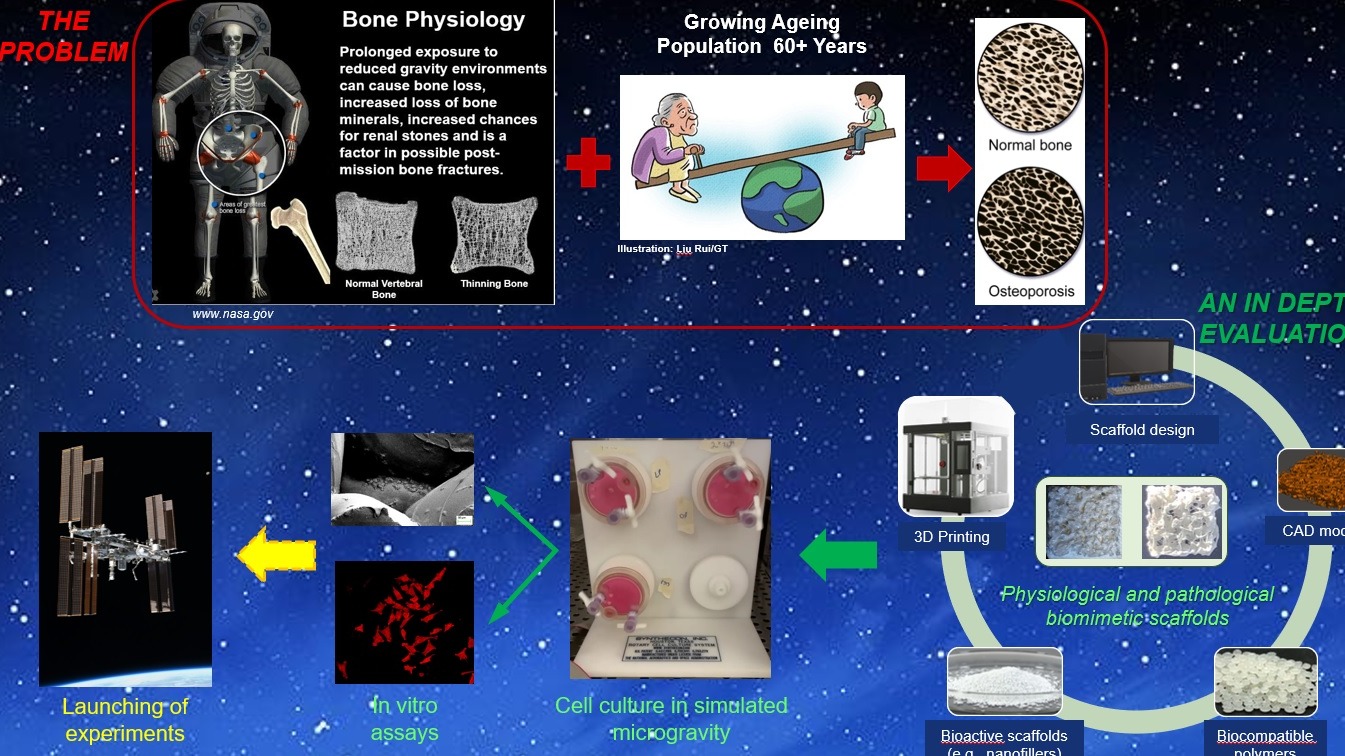Bone mass loss is a consequence of microgravity exposure (about 1.5%/month) and effective countermeasures are still to come as, after returning to Earth, the recovery takes 3-4 years. Demineralization enhances calcium excretion with a balance decrease of about 250 mg/day during flight [1,2]. Skeletal unloading leads to an altered homeostasis, a reduction in bone mineral density, an increase of fracture risk, and a premature osteoporotic phenotype [3].
An experimental strategy to further elucidate the results already collected, and provide innovative models for space research, is highly recommended if referred to the planned long-distance missions (e.g., Moon, Mars), due to gravity variability and to the related biological affections. For this aim, bone-like scaffolds capable of limiting cell dysfunctions can pave the way to novel protocols for treating microgravity-related issues [4].
Innovative 3D printed scaffolds are thus proposed to mimic the bone trabecular structure for developing ad hoc regenerative strategies, considered so far by a very limited number of studies [5-7]. Biomimetic scaffolds can actually support the assessment of physio-pathological conditions to highlight cellular mechanisms, refine existing therapeutic protocols, and develop new countermeasures. Microgravity leads bone marrow stromal cells to preferentially differentiate to adipogenic instead to osteogenic lineage cells which is comparable to aging. Therefore, the investigation of microgravity issues can contribute to the comprehension of aging effects [3], representing an accelerated study model according to the “Life Sciences, Biotech & Pharma” BSGN programme. Collected data are expected to
- assess the role of bone-like microarchitecture in cell-scaffold interaction,
- provide cells with biomaterials cues,
- analyse biomarkers in microgravity,
- evaluate a possible counteract input from 3D printed bone replicas, and
- develop a gravity-dependent tissue engineering approach.
_____
- NASA website “Preventing Bone Loss in Spaceflight with Prophylactic use of Bisphosphonate: Health Promotion of the Elderly by Space Medicine Technologies” (https://www.nasa.gov/mission_pages/station/research/news/b4h-3rd/hh-preventing-bone-loss-in-space).
- Arfat Y, Xiao WZ, Iftikhar S, Zhao F, Li DJ, Sun YL, Zhang G, Shang P, Qian AR. Physiological effects of microgravity on bone cells. Calcif Tissue Int. 2014;94(6):569-79. doi: 10.1007/s00223-014-9851-x.
- Juhl OJ 4th, Buettmann EG, Friedman MA, DeNapoli RC, Hoppock GA, Donahue HJ. Update on the effects of microgravity on the musculoskeletal system. NPJ Microgravity. 2021;7(1):28. doi: 10.1038/s41526-021-00158-4.
- Avitabile E, Fusco L, Minardi S, Orecchioni M, Zavan B, Yilmazer A, Rauner M, Pippia P, Tasciotti E, Delogu LG. Bioinspired Scaffold Action Under the Extreme Physiological Conditions of Simulated Space Flights: Osteogenesis Enhancing Under Microgravity. Front Bioeng Biotechnol. 2020;8:722. doi: 10.3389/fbioe.2020.00722.
- Pecci R, Baiguera S, Ioppolo P, Bedini R, Del Gaudio C. 3D printed scaffolds with random microarchitecture for bone tissue engineering applications: Manufacturing and characterization. J Mech Behav Biomed Mater. 2020;103:103583.
- Ledda M, Merco M, Sciortino A, Scatena E, Convertino A, Lisi A, Del Gaudio C. Biological response to bioinspired microporous 3D-printed scaffolds for bone tissue engineering. Int J Mol Sci. 2022;23:5383.
- Mochi F, Scatena E, Rodriguez D, Ginebra MP, Del Gaudio C. Scaffold-based bone tissue engineering in microgravity: potential, concerns and implications. npj Microgravity ACCEPTED
- Lu H, Zhou Y, Ma Y, Xiao L, Ji W, Zhang Y, Wang X. Current application of beta-tricalcium phosphate in bone repair and its mechanism to regulate osteogenesis. Front Mater. 2021;8:698915.
- Maia MT, Soares ALdB, Caetano MA, Andrade FK, Rodríguez-Castellón E, Vieira RS. Biomimetic strontium substituted calcium phosphate coating for bone regeneration. Coatings. 2021;11:908.
- Baheiraei N, Eyni H, Bakhshi B, Najafloo R, Rabiee N. Effects of strontium ions with potential antibacterial activity on in vivo bone regeneration. Sci Rep. 2021;11(1):8745.

